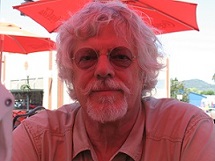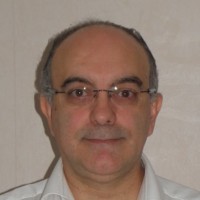
|
|
|
Plenary talks
PLENARY SPEAKERS
|
Eckehard Schöll |
Suzanne Lenhart |
Franco Blanchini |
|
Carsten Schneider |
Piotr Oprocha |
Azmy S. Ackleh |
|
Gian Italo Bischi |
Dorothée Normand-Cyrot |
Silviu-Iulian Niculescu |
|
Hinke Osinga |
Erik I. Verriest |
JDEA prize talk |
July 21, 2022
PLENARY TALK
Synchronization patterns and chimera states in networks of coupled maps
13:30 - 14:30
Eckehard Schöll (Technische Universität Berlin, Germany)
|
Abstract Chimera states are an intriguing example of partial synchronization patterns emerging in nonlocally coupled networks of identical chaotic time-discrete maps or time-continuous oscillators. They consist of spatially coexisting domains of coherent (synchronized) and incoherent (desynchronized) dynamics. We show that a plethora of partial synchronization scenarios including chimeras arise for various network topologies like one-dimensional ring networks, quasi-fractal connectivities, two-dimensional lattices, or multi-layer structures, and different dynamical maps. In particular, we study the logistic map, the Hénon map and the Lozi map. By analyzing the dependence of the spatiotemporal dynamics on the range and strength of coupling, we uncover dynamical bifurcation scenarios for the transition from coherence to complete incoherence via chimera states, and review numerical and analytial approaches [1-5]. Biography Eckehard Schöll is a Professor of Theoretical Physics at TU Berlin, a Guest Scientist at the Potsdam Institute for Climate Impact Research, and a Principal Investigator of the Bernstein Center for Computational Neuroscience Berlin. He studied physics at the University of Tübingen (Germany), and holds PhD degrees in mathematics from the University of Southampton (UK, 1978) and in physics from RWTH Aachen (Germany, 1981), and an Honorary Doctorate from Saratov State University (Russia, 2017). He is an expert in the field of nonlinear dynamical systems and head of the group Nonlinear Dynamics and Control. His work pertains to research in the fields of mathematics and physics, particularly semiconductor physics, laser physics, neurodynamics, complex systems and networks, and bifurcation theory. His latest research is also related to topics in biology and the social sciences, e.g. simulation of the dynamics in socioeconomic, physiological, or neuronal networks and power grids. He is one of the forerunners into the research of chimera states. |
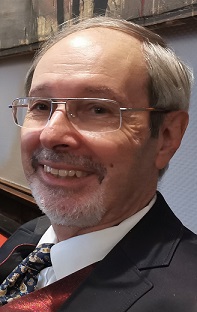 |
July 19, 2022
PLENARY TALK
Two applications of discrete population models with hybrid features
15:00 - 16:00
Suzanne Lenhart (University of Tennessee)
|
Abstract Discrete models may have hybrid features due to a variety of mechanisms. We will present two examples of hybrid models, one with some mechanisms between time steps and the other with a shorter time scale embedded in the main time scale processes. In our first example, we present mechanistic models featuring within‐season harvest timing and level. Between discrete population census times, there are continuous density-dependent mortality rates. We explore optimal control of the harvest level and timing of these population models. Maximizing the yield while minimizing the costs of management can lead to unexpected oscillation patterns in the population. In our second example, we find the relationship between air temperature and emergence success of hatchlings across multiple nesting seasons to better understand the potential impact of climate change on Loggerhead sea turtle populations. We want to investigate the effect of changing hatchling emergence success on the juvenile and adult populations. The results of a statistical model of emergence success feed into the dynamics during the nesting seasons of the eggs and hatchlings in a submodel on daily time scale. The submodel is connected to an age-structure model with two juvenile and one adult classes on a yearly time scale. We illustrate the effect of temperature changes across these life stages. Biography Suzanne Lenhart is a Chancellor's professor in the Department of Mathematics at the University of Tennessee, Knoxville. She was a part-time research staff member at Oak Ridge National Laboratory for 22 years. She is a recognized expert in optimal control and ordinary and partial differential equations, with modeling applications to populations, natural resources, invasive species, and diseases. She has authored many journal articles, as well as two texts, Optimal Control applied to Biological Models and Mathematics for the Life Sciences. She was the President of the Association for Women in Mathematics in 2001-2003. She received fellow awards from SIAM, AMS, AWM, and AAAS. She was the Associate Director for Education and Outreach of the National Institute for Mathematical and Biological Synthesis for the last 12 years. Lenhart has been the director of Research Experiences for Undergraduates summer programs on her campus for 27 years. |
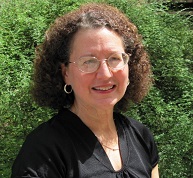 |
July 19, 2022
CentraleSupelec Foundation's PLENARY TALK
Mathematics of Mechanisms
11:00 - 12:00
Franco Blanchini (Udine University, Italy)
|
Abstract Systems and control theory has developed many techniques borrowing tools from different branches of mathematics. Interestingly, many of the techniques conceived and routinely used to solve control problems can be quite successfully adapted to solve new relevant problems, both practical and curiosity-driven, in other fields. Franco Blanchini was born on 29 December 1959, in Legnano (Italy). He is the Director of the Laboratory of System Dynamics at the University of Udine. He has been involved in the organization of several international events: in particular, he was Program Vice-Chairman of the conference Joint CDC-ECC 2005, Seville, Spain; Program Vice-Chairman of the Conference CDC 2008, Cancun, Mexico; Program Chairman of the Conference ROCOND, Aalborg, Denmark, June 2012 and Program Vice-Chairman of the Conference CDC 2013, Florence, Italy. He is co-author of the book "Set theoretic methods in control", Birkhauser. He received the 2001 ASME Oil & Gas Application Committee Best Paper Award as a co-author of the article "Experimental evaluation of a High-Gain Control for Compressor Surge Instability", the 2002 IFAC prize Survey Paper Award as the author of the article "Set Invariance in Control - a survey", Automatica, November 1999, for which he also received the High Impact Paper Award in 2017, and the 2017 NAHS Best Paper Award as a co-author of the article "A switched system approach to dynamic race modelling", Nonlinear Analysis: Hybrid Systems, 2016. He has been plenary speaker at the IFAC Joint Conference, Grenoble, February 2013, plenary speaker at the 32nd Benelux Meeting on Systems and Control, and semi-plenary speaker at the IEEE CDC 2020, Jeju, Japan. He has been an Associate Editor for Automatica and for IEEE Transactions on Automatic Control. He has been a Senior Editor for IEEE Control Systems Letters. |
 |
July 20, 2022
PLENARY TALK
Symbolic Summation, linear difference equations and challenging applications
12:00 - 13:00
Carsten Schneider (Johannes Kepler University, Austria)
|
Abstract Inspired by Karr's summation algorithm (1981), an advanced summation framework has been developed in the last 20 years that can deal with indefinite and definite multi-sum expressions. The underlying backbone is an algorithmic difference ring theory which enables one to rephrase expressions in terms of indefinite nested sums and products completely automatically to canonical form representations. As a by-product, the computed expressions are built by sums and products that are algebraically independent among each other. Together with general and highly efficient difference ring algorithms for recurrence finding (based on Zeilberger's creative telescoping paradigm) and recurrence solving, one can simplify huge expressions of multi-sums (and related multi-integrals) to certain classes of special functions defined by iterated sums (and integrals). In a nutshell, the developed algorithms for symbolic summation and special functions provide a flexible toolbox that can tackle challenging problems coming, e.g., from combinatorics, special functions, number theory, statistics, or particle physics (a long-term collaboration with DESY, the Deutsches Elektronen-Synchrotron). In this talk the underlying difference ring theory and the available summation tools in this setting will be illustrated by concrete examples that are hard to solve or that could not be solved by other methods so far. Biography After his computer science studies at the Friedrich-Alexander-University Erlangen-Nürnberg, Carsten Schneider could intensify his scientific interests in the field of computer algebra at the internationally well recognized Research Institute for Symbolic Computation (RISC) of the Johannes Kepler University Linz. There he completed his PhD in 2001, obtained the Habilitation in the field of mathematics in 2008, and serves recently as full processor and vice-director of RISC. His main research area is symbolic computation: he explores advanced mathematical theories in algebra, in particular in formal rings equipped with ring automorphisms. In this general setting of difference rings, he puts special emphasis on the design of non-trivial algorithms in symbolic summation and finding solutions of linear recurrences. Besides the development of new algorithmic theories, he devotes energy in the design and implementation of user friendly computer algebra packages. Notably, his research has been motivated strongly by concrete and challenging problems, e.g., in number theory (harmonic number identities related to zeta-values and generalizations of them), numerics (Pade approximations, finite element methods), and in particular in combinatorics. In addition, he started 15 years ago an interdisciplinary project with the theory group of the Deutsches Elektronen-Synchrotron (DESY, Zeuthen, Prof. Dr. Johannes Blümlein and Dr. Peter Marquard). In this intensive and fruitful cooperation, they are developing new algorithms for quantum field theories and elementary particle physics. These ongoing large-scale calculations of massive 3--loop Feynman integrals (leading so far to about 80 joint publications) will be used, e.g., for the precision measurements of the Hadron Electron Ring Accelerator (HERA) of the Deutsches Elektronen Synchrotron and of the Large Hadron Collider (LHC) of CERN. |
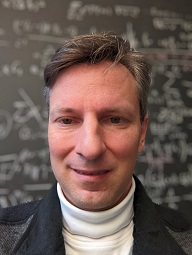 |
July 20, 2022
PLENARY TALK
On typical properties of Lebesgue measure preserving maps in dimension one
10:00 - 11:00
Piotr Oprocha (AGH University of Science and Technology, Poland)
(joint work with Jernej Činč, Jozef Bobok and Serge Troubetzkoy)
|
Abstract In this talk I will discuss selected properties of generic continuous maps of the interval and circle which preserve the Lebesgue measure. I will focus on a few natural properties such as entropy, the structure of periodic points, mixing properties, shadowing properties, etc. I will also highlight properties of generic maps compared to other possible dynamical behaviors within maps preserving Lebesgue measure.
|
 |
July 18, 2022
PLENARY TALK
Application of Discrete-Time Stage Structured Models to Understand the Dynamics of a Tick Population and Associated Pathogens
11:00 - 12:00
Azmy S. Ackleh (University of Louisiana, USA)
|
Abstract We develop a discrete-time model that describes tick-host population dynamics and incorporates the developmental stages for an individual tick. We study the global dynamics of this system and show that if the inherent net reproductive number is greater than one, then the unique interior equilibrium is globally asymptotically stable. We extend the model to a tick-host-pathogen model to describe the spread of a disease in a hard-bodied tick species. We apply the model to two pathogens and numerically study properties of the invasion and establishment of a disease. In particular, we consider the basic reproduction number, which determines whether a disease can invade the tick-host system, as well as disease prevalence and time to establishment in the case of successful disease invasion. Using Monte Carlo simulations, we calculate the means of each of these disease metrics and their elasticities with respect to various model parameters. We then extend the population model to include spatial movement of ticks and their hosts and analyze the dynamics of the model under a nonlinear fecundity term that exhibits an Allee effect. We show that the system has rich dynamics including monostable and bistable dynamics. We incorporate demographic stochasticity into the model and use numerical simulations to understand spatial invasion patterns of ticks as they relate to different dispersal mechanisms. Azmy S. Ackleh is the R.P. Authement Eminent Scholar and Endowed Chair in Computational Mathematics and the Dean of the College of Sciences at the University of Louisiana at Lafayette. He received his Ph.D. from the University of Tennessee at Knoxville in 1993 and then joined the Center for Research in Scientific Computation at North Carolina State University as a postdoctoral fellow. In 1995 he joined the Department of Mathematics at the University of Louisiana as an Assistant Professor. In 2000 he became an Associate Professor of Mathematics and in 2003 he became a Full Professor of Mathematics in that Department. |
 |
July 18, 2022
PLENARY TALK
Discrete dynamic models in social sciences: strategic interaction, rationality, evolution.
13:30 - 14:30
Gian Italo Bischi (Università di Urbino Carlo Bo, Italy)
|
Abstract Discrete-time dynamical systems naturally arise in economic and social modelling, because changes in the state of a system occur as a consequence of decisions (event-driven time). Given a characteristic time interval, taken as a unit of time advancement, then the state at the next time period is obtained by the application of a map, i.e. a point transformation defined in a n-dimensional state space into itself. Indeed, in social sciences rational agents are assumed to choose their actions through an optimal decision process, with complete information about the environment and the other agents’ choices. However, humans are sometimes not so rational nor informed, and they behave following adaptive methods, such as learning-by-doing or trial-and-error practices. This leads to replace one-shot optimal decisions with repeated adaptive decisions, in other words a dynamic process that may or may not converge to a rational equilibrium. Moreover, several attracting sets may coexist, so that the step-by-step adaptive process may act as a selection device and a global study of the basins of attraction can gives information about the path dependence, i.e. how the long-run time evolution depends on historical accidents (represented by exogenous shifts of initial conditions). For example, in repeated oligopoly games strategic choices may never settle to a Nash equilibrium, and continue to move around it, following some periodic or chaotic time patterns, or they may even irreversibly depart from it. Sometimes different decision strategies may be adopted by heterogeneous interacting agents, leading to different time adjustment processes characterized by different performances. In these cases evolutionary games can be used to model populations of players subdivided into fractions adopting different strategies, and considering endogenous switching process driven by payoff gradients (such as replicator dynamics or imitate the better mechanisms). Evolutionary game theory, initially developed in the context of biological systems, considers the behavior of large populations of agents who repeatedly engage in strategic interactions. In the biological interpretation, a population consists of animals which are genetically programmed to use some strategy that is inherited by its offspring, whereas in the economic interpretation the agents are assumed to play the game many times and consciously switch strategies driven by imitation of more successful opponents. The iterated maps that model such time evolutions in discrete time are generally nonlinear and are often noninvertible. Hence their folding and unfolding properties characterize the attractors and their basins respectively ReferencesBischi G.I., Lamantia F., Scardamaglia B., “On the influence of memory on complex dynamics of evolutionary oligopoly models”, Nonlinear Dynamics, 102(2), (2020) 1097-1110 Radi D., Lamantia F., Bischi G.I. “Offshoring, Reshoring, Unemployment, and Wage Dynamics in a Two-Country Evolutionary Model”, Macroeconomic Dynamics, 25 (2021) 705-732 Bischi, G.I. Merlone U., Pruscini E. "Evolutionary dynamics in club goods binary games", Journal of Economic Dynamics and Control, 91 (2018) 104-119. Biography Gian-Italo Bischi. Full professor of “Mathematics for economic and social sciences” at the department DESP (Department of Economics, Society, Politics) of the University of Urbino (Italy) is author of several articles and books on nonlinear dynamic models and their applications to the description of complex systems, ranging from physics and biology up to economics and social sciences. He mainly uses methods from the qualitative theory of nonlinear dynamical systems, also in connection with game theory and in particular evolutionary games. He also deals with the popularisation and communication of mathematical ideass, with a particular focus on connections between mathematics and other cultural fields, like literature and art. |
 |
July 18, 2022
PLENARY TALK
Nonlinear Discrete-Time Dynamics in Port-Hamiltonian Form
17:00 - 18:00
Dorothée Normand-Cyrot (CNRS, France)
|
Abstract Port-Hamiltonian structures have a pervasive impact in numerous applied domains enlarging the more traditional mechanical one. These structures are essentially described in the continuous-time domain while in discrete time, a consensus on a specific structure is not yet reached in spite of a rich literature. In this talk we propose a novel description of port-Hamiltonian structures for nonlinear discrete-time dynamics. We start from a novel representation of controlled nonlinear difference equations as two coupled difference and differential equations. On this basis, a novel notion of passivity for discrete-time systems is introduced that serves to describe port-Hamiltonian forms. We show how damping feedback and energy-based control strategies can be designed on these forms. These structures are validated through the description of the associated Dirac structure and showing closedness under power preserving interconnection. To conclude, we investigate how these forms are transformed under time-integration to recover sampled-data port-Hamiltonian structures thanks to a modification of the interconnection and dissipation matrices characterizing the dynamics. Some simulations are presented to illustrate the validity and control performances of these forms.Biography Dorothée Normand-Cyrot received the PhD degree in Mathematics and es-Sciences Doctorat d’Etat in Physics from University Paris VII and Paris Sud in 1978 and 1983 respectively. She joined the French National Center of Scientific Research (CNRS) in 1981 at the Laboratory of Signal and Systems (L2S), Paris Saclay, where she was Research Director from 1991 and currently Emeritus from 2021. She is an IEEE Fellow (class 2005) of the Control Systems Society for Contributions to Digital and Discrete-Time Control Systems. Since 1983, she promoted research activity within Europe and in particular with Italy, holding many visiting positions at the University of Rome La Sapienza through a mobility network on Sciences and Technologies for Information and Control and its Applications (AML-STICA) under the auspices of the French-Italian University UFI/UIF. Her research interest is in the field of nonlinear control theory with focus on discrete-time and digital systems; she is author and co-author of about 217 scientific publications, supervisor of nearly 30 PhD students; recipient of the IFAC-Control Engineering Practice Best Paper Award for 2011/13. Among others, she was Director of the CNRS Groupement de Recherche in Control Theory (GdR-A) from 1998 to 2002; Programme Chair of the ECC-91, Grenoble, France; General Chair of the Workshop Perspectives in Control in 1998, General Chair of CIFA2002 ”Conference Internationale Francophone d’Automatique” in Nantes, France. Member of several scientific and steering international committees, she was Funding Member of the European Union Control Association EUCA’91 and Editor at Large of the European Journal of Control from 2003. |
 |
July 21, 2022
PLENARY TALK
Phase resetting as a two-point boundary value problem
10:00 - 11:00
Hinke Osinga (Auckland University, New Zealand)
|
Abstract Phase resetting is used in experiments with the aim to classify and characterise different neurons by their responses to perturbations away from a periodic bursting pattern. The same approach can also be applied numerically to a mathematical model. Resetting is closely related to the concept of isochrons of a periodic orbit, which are the submanifolds in its basin of attraction of all points that converge to this periodic orbit with a specific phase. Until recently, such numerical phase resets were performed in an ad-hoc fashion, and the development of suitable computational techniques was only started in the last decade or so. We present an approach based on the continuation of solutions to a two-point boundary value problem that directly evaluates the phase associated with the isochron that the perturbed point is located on. We illustrate this method with the FitzHugh–Nagumo model and investigate how the resetting behaviour is affected by phase sensitivity in the system.Biography Hinke Osinga is Professor of Applied Mathematics at the University of Auckland, New Zealand. Her research focuses on dynamical systems theory and the development and application of numerical methods for computing invariant manifolds. Her publications, illustrations, animations and outreach activities have made her famous worldwide in the mathematics and arts communities. She received the 2016 Research Award of the New Zealand Mathematical Society and is a Fellow of the Royal Society of New Zealand, Fellow of the New Zealand Mathematical Society, and Fellow of the Society for Industrial and Applied Mathematics. She obtained her PhD from the University of Groningen, the Netherlands, and has held previous positions at the Universities of Bristol and Exeter in the UK, and Cornell University, California Institute of Technology and the Geometry Center in the USA. |
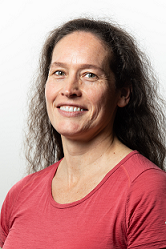 |
July 19, 2022
JDEA Best Paper -- PLENARY TALK
From elliptic curves to bifurcation theory: differentiable versus topological conjugacy.
13:00 - 14:00
Paul Glendinning (University of Manchester, UK)
|
Abstract Conjugacy describes how two maps may be related via a change of coordinate. In [1] we show that the dynamics induced by a simple geometric construction on elliptic curves (taking the tangents to the curve at a point and mapping to the other intersection of the tangent to the curve or the point at infinity) creates a map topologically conjugate to the chaotic map x -->2-x^2 on [-2; 2]. Moreover, despite the fact that the numerically computed maps obtained in this way can look very different depending on the parameters of the elliptic curve, they are in fact C1-conjugate. Differentiable conjugacies preserve the stability multipliers of periodic orbits, so in chaotic maps with infinitely many periodic orbits, the existence of differentiable conjugacies is rare. P. Glendinning and S. Glendinning (2021) Smooth conjugacy of difference equations derived from elliptic curves, J. Di. Equ. & Appl. Biography Paul Glendinning is Professor of Applied Mathematics at the University of Manchester. He works on bifurcation theory and piecewise smooth dynamics. He was awarded a PhD from the University of Cambridge in 1985, and after post-docs in Warwick and Cambridge he was a lecturer in Cambridge and then moved to chairs at Queen Mary, University of London, and Manchester (UMIST and University of Manchester). He was the founding Head of School in Mathematics during the merger of UMIST and Manchester (2003-2008), and has been Scientific Director of ICMS, Edinburgh (2016-2021). He is currently President of the IMA, one of the UK Learned Societies for mathematics. He was elected a Fellow of the Royal Society of Edinburgh in 2021. Photograph by Sasha Glendinning |
 |
July 21, 2022
PLENARY TALK
Delays, Interconnections and Control. A Guided Tour
17:00 - 18:00
Silviu-Iulian Niculescu (CNRS, France)
|
Abstract To better grasp the heterogeneity of the temporal phenomena in systems' dynamics, knowledge of “past” may appear as essential to derive appropriate models, and there exists a wide variety of processes in nature with such characteristics. In these cases, the use of delays in the representation of such phenomena may help to better understand the underlying mechanisms or of the interactions/coupling with other (eventually spatial) phenomena. In this context, a particular case is represented by the interconnection of dynamical systems. It is well-known that the interconnection of two or more dynamical systems leads to an increasing complexity of the behavior of the global system due to the effects induced by the emerging dynamics (in the presence or not of feedback loops) in strong interactions (sensing, communication) with environment changes. One of the major problems appearing in such interconnection schemes is related to the propagation, transport, and communication delays acting “through” and/or “inside” the interconnections. Such systems are governed by a particular type of differential equations, namely delay-differential equations. The purpose of this talk is to briefly present some “user-friendly” (frequency-domain) methods and techniques for the analysis and control of the dynamical systems in the presence of constant (pointwise) delays by emphasizing how the delay, seen as a parameter, can affect the exponential stability of the system. As a by-product of such an analysis, the use of the delay as a control parameter will open up interesting perspectives to exploit further. The presentation is as simple as possible, emphasizing the main intuitive ideas to develop theoretical results, and their potential use in practical applications. Various illustrative examples complete the presentation (joint work with Keqin GU, Southern Illinois University at Edwardsville, USA). Biography Silviu-Iulian NICULESCU received the B.S. degree from the Polytechnical Institute of Bucharest, Romania, the M.Sc., and Ph.D. degrees from the Institut National Polytechnique de Grenoble, France, and the French Habilitation (HDR) from Université de Technologie de Compiègne, all in Automatic Control, in 1992, 1993, 1996, and 2003, respectively. He is currently Research Director at CNRS (French National Center for Scientific Research), L2S (Laboratory of Signals and Systems), a joint research unit of CNRS with CentraleSupélec and Université Paris-Saclay located at Gif-sur-Yvette. Dr. Niculescu is a member of the Inria team “DISCO” and he was the head of L2S for a decade (2010-2019). He is author/coauthor of 11 books and of more than 600 scientific papers. His research interests include delay systems, robust control, operator theory, and numerical methods in optimization, and their applications to the design of engineering systems. Since 2017, he is the Chair of the IFAC TC “Linear Control Systems” and he served as Associate Editor for several journals in Control area, including the IEEE Transactions on Automatic Control (2003-2005). IEEE Fellow since 2018, Doctor Honoris Causa of University of Craiova (Romania) since 2016, Founding Editor and Editor-in-Chief of the Springer Nature Series “Advances in delays and dynamics” since its creation in 2012, Dr. Niculescu was awarded the CNRS Silver and Bronze Medals for scientific research and the Ph.D. Thesis Award from Grenoble INP (France) in 2011, 2001 and 1996, respectively. For further information, please visit https://cv.archives-ouvertes.fr/silviu-iulian-niculescu |
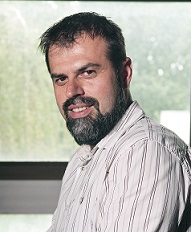 |
July 22, 2022
PLENARY TALK
Stability and Realization of Difference Equations over ℤ and ℝ
10:00 - 11:00
Erik I. Verriest (Georgia Tech, USA)
|
Abstract For LTI (ordinary) difference equations, the Jury (and mapped Routh-Hurwitz) tests provide necessary and sufficient conditions for stability. Our first aim is to show some sufficient conditions of much lower complexity for stability of a subclass of “sparse” systems, and show that this is can be accomplished by a Riccati-equation type condition. These criteria can also be expressed in terms of function-theoretic concepts. We then extend these results to time-variant (delay) difference equations, where problems with wellposedness and causality may occur. Such analyses are instrumental for stability analysis of delay equations and as a singular limit for delay-differential equations. Much of this is joint work with A. Ivanov. The second part of the talk deals with difference equations defined over and ℝ rather than ℤ. In particular, the cases with time-varying and state-dependent delay present new problems. First, an appropriate state space for such systems is sought, as this is a prerequisite for precise notions of what is meant by a trajectory and its stability. Then we discuss the infinitesimal generator. This leads then to implicit iterations of the form x(t) = f(x(t−1), x(t−τ(x(t))), modeling certain systems with state-dependent delay, τ(x). While here t ∈ ℝ, we show that a discrete event-structure (i.e, space-time structure) is appropriate for its description, and certain iterated functional equations are instrumental for characterizing solutions. Finally, for nonhomogeneous linear difference equations, i.e., models of discrete input-output systems, we present in part 3 some intricate problems regarding loss of causality and its consequences if the delay is switched. Fixes, known as lossless causalization and forgetful causalization are discussed. Biography Erik I. Verriest is the Director of the Mathematical System Theory Laboratory (MAST Lab) at the Georgia Institute of Technology. He was with the Control Systems Laboratory and the Hybrid Computation Centre, Ghent, Belgium in 1973-1974, obtained the Ph.D. degrees from Stanford University and joined the faculty of Electrical and Computer Engineering at the Georgia Institute of Technology in 1980. His present interests are in mathematical system theory. He contributed to the theory of periodic and hybrid systems, delay-differential systems, model reduction for nonlinear systems, control with communication constraints, locomotion and optimal control. He served on several conference IPC’s and is a member of the IFAC Committee on Linear Systems, a Fellow of the IEEE (2012), a member of the Royal Flemish Academy of Belgium for Science and the Arts (elected 2012), and a Distinguished Professor of ECE, Georgia Tech (2014). He was a plenary speaker at the 2nd IFAC Workshop on Linear Time Delay Systems in Grenoble (2000) and the 13-th IFAC Workshop on Time Delay Systems in Istanbul (2016). Presently he holds the Giovanni Prodi Chair at the Mathematics Institute of the Julius Maximilians Universität Würzburg, Germany. |
|
July 20, 2022
Invited industrial talk
How to effectively evaluate the stability of large power systems, including short-term stochastic behaviors
11:00 - 12:00
Patrick Panciatici
Scientific Advisor at RTE (French TSO)
|
Abstract Stability assessment of large power systems is usually performed using time domain simulation. Numerical schemes have been developed in the last decades, based on hybrid DAE solvers (with switches) using a predictor-corrector approach (typically IDA from sundials: IDA | Computing (llnl.gov)). They are quite efficient in the deterministic case. But in fact, there are always short-term stochastic effects in large power systems that are neglected in this type of stability assessment, Unfortunately, the deterministic approach does not verify that these stochastic effects do not excite instabilities and our classical predictor-corrector approach seems incompatible with noise addition. In the presentation, we will present an example and a formulation of the problem. Biography Patrick Panciatici is a graduate of Supélec. He joined EDF R&D in 1985 and then RTE in 2003 when he participated in the creation of an internal R&D department at RTE. He has more than 35 years of experience in power systems: modeling, simulation, control and optimization. Currently, as a scientific advisor, he inspires and coordinates RTE's long-term research on the "system" dimension. He interacts with a large network of international experts and with academic teams worldwide on these topics. He is a member of CIGRE, Fellow of IEEE, RTE representative in PSERC and Bits & Watts. |
|
Check out the PLENARY TALKS of the next IFAC CAO 2022 held at the same time in the same location.
